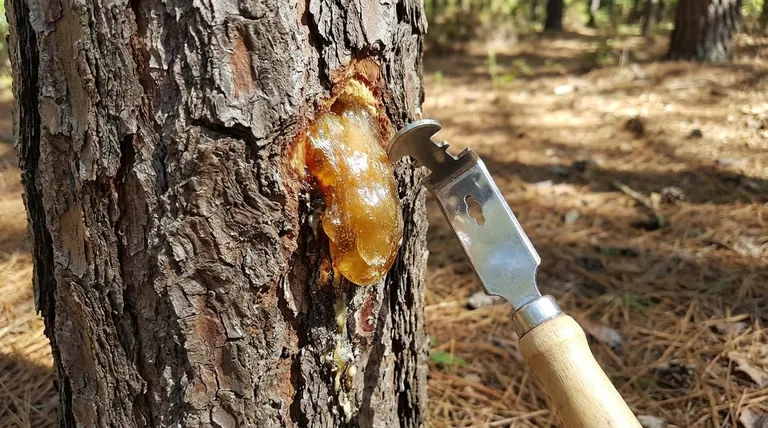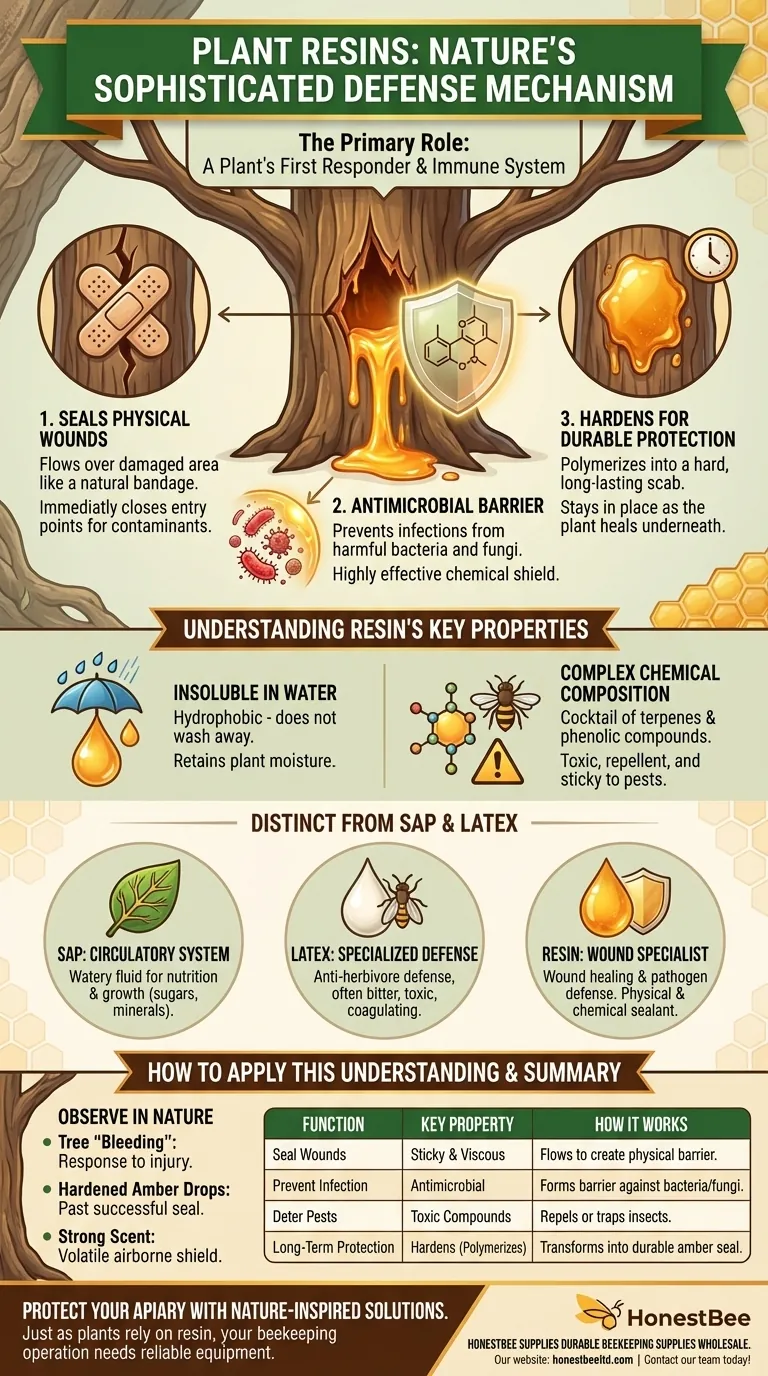In nature, plant resins function as a sophisticated defense mechanism. When a plant is injured, it releases this sticky, viscous substance to seal the wound, creating a physical and chemical barrier that protects it from infection and further harm.
Think of resin as a plant's external immune system and first-aid kit combined. It physically seals injuries to prevent threats from entering, while its chemical properties actively fight off pathogens and deter pests.

The Primary Role: A Plant's First Responder
When a plant's bark or stem is broken, it becomes vulnerable. Resin is the immediate response to this crisis, acting swiftly to contain the damage.
Sealing Physical Wounds
Resin is produced in specialized cells and canals. Upon injury, it oozes out and flows over the damaged area, much like a natural bandage.
This initial liquid flow ensures complete coverage of the wound, immediately closing the entry point for outside contaminants.
Creating an Antimicrobial Barrier
The most critical function of this seal is to keep out harmful microorganisms. The resin barrier is highly effective at preventing infections from bacteria and fungi that would otherwise invade the plant's vulnerable tissue.
Hardening for Durable Protection
Once exposed to the air, the liquid resin begins to harden. This process, called polymerization, transforms the sticky fluid into a hard, solid scab.
This durable, amber-like seal provides long-lasting protection, remaining in place as the plant heals underneath.
Understanding Resin's Key Properties
The effectiveness of resin is not accidental; it stems from a few key physical and chemical properties that make it perfectly suited for its defensive role.
Insolubility in Water
Resins are hydrophobic, meaning they do not dissolve in water. This is a critical feature, as it ensures the protective seal will not wash away in the rain.
This insolubility also helps the plant retain its own moisture, preventing the wound from dehydrating.
Complex Chemical Composition
Resins are a cocktail of complex organic compounds, including terpenes and phenolic compounds. These chemicals are not inert; they are often toxic or repellent to a wide range of threats.
The strong, often aromatic scent of many resins (like pine) is a direct result of these volatile compounds, which can deter feeding insects and herbivores. The sticky texture can also trap smaller insects, neutralizing them completely.
The Difference Between Resin, Sap, and Latex
It's common to confuse these plant secretions, but they have distinct functions and compositions. Understanding the difference highlights the specialized role of resin.
Sap: The Plant's Circulatory System
Sap is a watery fluid rich in sugars, minerals, and hormones. It circulates nutrients throughout the plant, analogous to blood in animals. It is primarily for nutrition and growth, not defense.
Latex: A Specialized Defense
Latex, like the milky fluid from a rubber tree or dandelion, is also a defensive substance. However, it is primarily an anti-herbivore defense, often being bitter, toxic, and coagulating quickly to gum up an insect's mouthparts.
Resin: The Wound Specialist
Resin's primary function is wound healing and pathogen defense. While it also deters herbivores, its main purpose is to act as a physical and chemical sealant for injuries.
How to Apply This Understanding
You can easily observe these principles in nature. Recognizing the purpose of resin allows you to better interpret the health and history of a plant.
- If you see a tree "bleeding" a sticky substance: You are likely witnessing the resin defense system responding to an injury, such as a broken branch or a hole bored by an insect.
- If you find hardened, amber-like drops on bark: This is the fully formed resin seal, a "scar" from a past injury that has been successfully protected.
- If you notice a strong, sharp scent from a conifer: You are smelling the volatile organic compounds in its resin, which serve as a constant, airborne chemical shield against pests.
Ultimately, resin is a testament to the elegant and effective survival strategies that plants have evolved to protect themselves.
Summary Table:
| Function | Key Property | How It Works |
|---|---|---|
| Seal Wounds | Sticky & Viscous | Flows over injuries to create a physical barrier. |
| Prevent Infection | Antimicrobial | Forms a barrier against bacteria and fungi. |
| Deter Pests | Toxic Compounds | Chemical properties repel or trap insects. |
| Long-Term Protection | Hardens (Polymerizes) | Transforms into a durable, amber-like seal. |
Protect Your Apiary with Nature-Inspired Solutions
Just as plants rely on resin for protection, your beekeeping operation needs reliable, high-quality equipment to thrive. HONESTBEE supplies durable beekeeping supplies and equipment to commercial apiaries and distributors through our wholesale-focused operations.
We help you build a stronger, more resilient business. Contact our team today to discuss your wholesale needs and discover the HONESTBEE difference.
Visual Guide

Related Products
- Professional Stainless Steel Frame Cleaner with Ergonomic Wood Handle
- Wide Adjustable Stainless Steel Honey Uncapping Fork with Scraper
- Stainless Steel Double Sided Honey Uncapping Fork with Scraper
- Professional Wide Blade Honey Scraper for Beekeeping and Honey Processing
- Extra Wide Stainless Steel Honey Uncapping Fork with Scraper Beekeeping Tool
People Also Ask
- What are the features of the frame cleaning tool? Ergonomic Design for Efficient Frame Maintenance
- When is the frame cleaning tool especially useful? Essential for Efficient Frame Reuse in Beekeeping
- When is the best time to perform scraping maintenance on hive surfaces? Minimize Stress for a Healthier Colony
- What are the two main care and maintenance tasks for hive tools? Protect Your Hives and Your Investment
- Why is a hive tool necessary for beekeeping? Your Essential Key to Opening the Hive



















